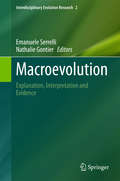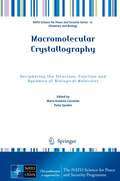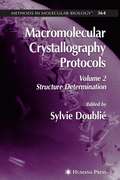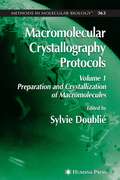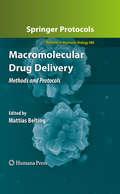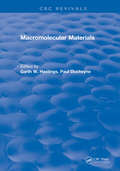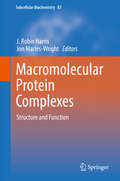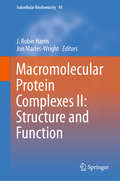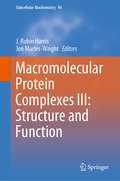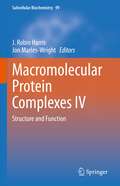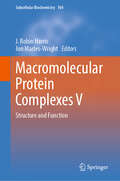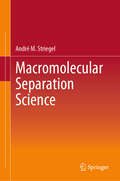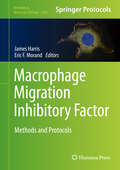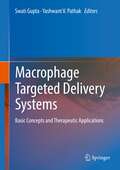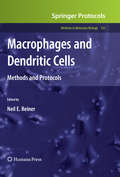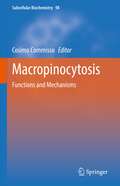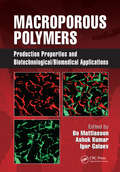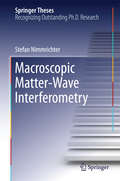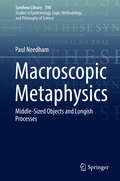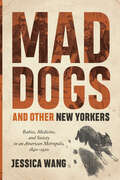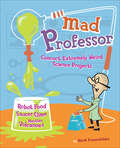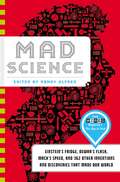- Table View
- List View
Macroevolution
by Nathalie Gontier Emanuele SerrelliThis book is divided in two parts, the first of which shows how, beyond paleontology and systematics, macroevolutionary theories apply key insights from ecology and biogeography, developmental biology, biophysics, molecular phylogenetics and even the sociocultural sciences to explain evolution in deep time. In the second part, the phenomenon of macroevolution is examined with the help of real life-history case studies on the evolution of eukaryotic sex, the formation of anatomical form and body-plans, extinction and speciation events of marine invertebrates, hominin evolution and species conservation ethics. The book brings together leading experts, who explain pivotal concepts such as Punctuated Equilibria, Stasis, Developmental Constraints, Adaptive Radiations, Habitat Tracking, Turnovers, (Mass) Extinctions, Species Sorting, Major Transitions, Trends and Hierarchies - key premises that allow macroevolutionary epistemic frameworks to transcend microevolutionary theories that focus on genetic variation, selection, migration and fitness. Along the way, the contributing authors review ongoing debates and current scientific challenges; detail new and fascinating scientific tools and techniques that allow us to cross the classic borders between disciplines; demonstrate how their theories make it possible to extend the Modern Synthesis; present guidelines on how the macroevolutionary field could be further developed; and provide a rich view of just how it was that life evolved across time and space. In short, this book is a must-read for active scholars and because the technical aspects are fully explained, it is also accessible for non-specialists. Understanding evolution requires a solid grasp of above-population phenomena. Species are real biological individuals and abiotic factors impact the future course of evolution. Beyond observation, when the explanation of macroevolution is the goal, we need both evidence and theory that enable us to explain and interpret how life evolves at the grand scale.
Macroevolution in Deep Time
by Alexander J. Bartholomew Rituparna BoseThe prerequisite to investigating the underlying causes behind mass extinction is a profound understanding of the evolutionary history of both living and dead species. It is especially important to appreciate the significance of such studies in extinct organisms; especially in organisms that were abundant in a certain geologic era, but have subsequently dwindled or become extinct. Such studies should help to accurately evaluate patterns of evolution in extinct species lineages and help predict the same in its modern analogs. The book includes cutting edge research in evolutionary biology that should serve as a starting point for conservation.
Macromolecular Crystallography
by Maria Armenia Carrondo Paola SpadonThis volume is a collection of the contributions presented at the 42nd Erice Crystallographic Course whose main objective was to train the younger generation on advanced methods and techniques for examining structural and dynamic aspects of biological macromolecules. The papers review the techniques used to study protein assemblies and their dynamics, including X-ray diffraction and scattering, electron cryo-electron microscopy, electro nanospray mass spectrometry, NMR, protein docking and molecular dynamics. A key theme throughout the book is the dependence of modern structural science on multiple experimental and computational techniques, and it is the development of these techniques and their integration that will take us forward in the future.
Macromolecular Crystallography Protocols: Structure Determination
by Sylvie DoublieMacromolecular Crystallography Protocols, now in two volumes, examines major developments that have occurred since publication of the acclaimed first edition nearly a decade ago. Volume 1 is composed of detailed protocols for the preparation and optimization of crystals. Volume 2 complements the first volume by addressing laboratory techniques for crystal handling and structural characterization. The volume concludes with a survey of available crystallographic software.
Macromolecular Crystallography Protocols: Volume 1, Preparation and crystallization of macromolecules
by Sylvie DoublieMacromolecular Crystallography Protocols, now in two volumes, examines major developments that have occurred since publication of the acclaimed first edition nearly a decade ago. Volume 1 is composed of detailed protocols for the preparation and optimization of crystals. Volume 2 complements the first volume by addressing laboratory techniques for crystal handling and structural characterization. The volume concludes with a survey of available crystallographic software.
Macromolecular Drug Delivery
by Mattias BeltingMacromolecular drugs hold the promise of becoming new therapeutics for several major disorders, including cancer and cardiovascular disease. This incredible potential is explored in Macromolecular Drug Delivery, a volume which gives a wide-ranging overview of contemporary methods used in the field, and which addresses the limitations presented by a lack of safe and efficient drug delivery strategies. Chapters offer information on both in vitro and in vivo methods of macromolecular delivery, thus appealing to a broad scientific audience. Composed in the highly successful Methods in Molecular BiologyTM series format, each chapter contains a brief introduction, step-by-step methods, a list of necessary materials, and a Notes section which shares tips on troubleshooting and avoiding known pitfalls. Comprehensive and cutting-edge, Macromolecular Drug Delivery offers a platform for interdisciplinary collaboration, which should provide opportunities for new discoveries at the interface between disciplines. Ultimately, this cooperation will lead to the use of macromolecular drugs as novel diagnostic tools and, even more importantly, as a means to revolutionize the way we view and treat diseases.
Macromolecular Materials
by HastingsThis volume deals with some basic considerations of structure and its relation to function. After outlining some basic principles in the first chapter, including manufacturing effects, structural determination is discussed in detail. This is important since adequate characterization in terms of molecular size is necessary for a proper understanding and suse. The theme of interrelationships between structure and properties is developed in the next chapters. The second part of the volume deals with selected applications in which the development and sue of macromolecultar materials in specific applications is described.The selection of applications includes synthetic and natural polymers and the range of medical areas involved include orthopedics, dialysis, drug release (macromolecular pharmacology) blood contact, and plastic surgery. Since the list could not be completely comprehensive, these represent areas of special development or of continuing problems.
Macromolecular Protein Complexes
by J. Robin Harris Jon Marles-WrightThis volume of the established Subcellular Biochemistry series presents 20 chapters dealing with a broad range of interesting protein complexes. It will enable researchers to readily appreciate the major contribution from both X-ray crystallography and cryo-electron microscopy in this field of study. The biological significance of these structural studies is emphasised throughout the book. The diversity of the material included here indicates the breadth of this field and the tremendous progress that has been made in recent years. The book is directed primarily to advanced students and researchers in structural biology, and others in the biochemical sciences. It will be supplemented by other related books within the Subcellular Biochemistry series. One of the Editors (JM-W) is actively involved in structural biology and the other (JRH), as a retired academic and the Series Editor of Subcellular Biochemistry, has long experience at editing multi-author books.
Macromolecular Protein Complexes II: Structure and Function (Subcellular Biochemistry #93)
by J. Robin Harris Jon Marles-WrightThis book follows on from Volume 83 in the SCBI series (“Macromolecular Protein Complexes”), and addresses several important topics (such as the Proteasome, Anaphase Promoting Complex, Ribosome and Apoptosome) that were not previously included, together with a number of additional exciting topics in this rapidly expanding field of study. Although the first SCBI Protein Complex book focused on soluble protein complexes, the second (Vol. 87)addressed Membrane Complexes, and the third (Vol. 88) put the spotlight on Viral Protein and Nucleoprotein Complexes, a number of membrane, virus and even fibrillar protein complexes have been be considered for inclusion in the present book. A further book is also under preparation that follows the same pattern, in an attempt to provide a thorough coverage of the subject.Chapter 9 is available open access under a Creative Commons Attribution 4.0 International License via link.springer.com.
Macromolecular Protein Complexes III: Structure and Function (Subcellular Biochemistry #96)
by J. Robin Harris Jon Marles-WrightThis book covers important topics such as the dynamic structure and function of the 26S proteasome, the DNA replication machine: structure and dynamic function and the structural organization and protein–protein interactions in the human adenovirus capsid, to mention but a few.The 18 chapters included here, written by experts in their specific field, are at the forefront of scientific knowledge. The impressive integration of structural data from X-ray crystallography with that from cryo-electron microscopy is apparent throughout the book. In addition, functional aspects are also given a high priority. Chapter 1 is available open access under a Creative Commons Attribution 4.0 International License via link.springer.com.
Macromolecular Protein Complexes IV: Structure and Function (Subcellular Biochemistry #99)
by J. Robin Harris Jon Marles-WrightThis book covers the latest findings of a wide variety of viral, prokaryotic and eukaryotic macromolecular protein complexes and builds upon the solid macromolecular foundations established by previous volumes of the Subcellular Biochemistry series. Thus, an almost encyclopaedic coverage of the broad field of protein complex structure and function has been established. The 17 interesting chapters included in this book have been organised into four sections: Soluble Protein Complexes, Membrane Protein Complexes, Fibrous Protein Complexes and Viral Protein Complexes. Significant topics present here are: Fatty Acid Synthase, the Fork Protection Complex, Ribonucleotide Reductase, the Kinetochore, G proteins, the FtsEX Complex, the Kainate Receptor, the Photosystem I-antenna, the Mycobacterial Arabinofuranosyltransferases, the the Bacterial Flagellum, the Actomyosin Complex, Motile Cilia, SLS Collagen Polymorphic Structures, and the Reovirus Capsid and Polymerase. Up-dates/expansion of chapter topics present in earlier volumes are now included in chapters here, e.g., those on Ferritin-like proteins and the Multi-tRNA Synthetase. The book is richly illustrated throughout, the result of an impressive integration of structural data from X-ray crystallography and cryo-electron microscopy. The functional aspects of protein-protein interactions are also given a high priority.
Macromolecular Protein Complexes V: Structure and Function (Subcellular Biochemistry #104)
by J. Robin Harris Jon Marles-WrightThis volume in the Subcellular Biochemistry (SCBI) series is a continuation of several previous volumes devoted to the structural and functional study of protein complexes. The expanding nature of this field of study, derived mainly from X-ray crystallography and electron cryomicroscopy, justifies the continuing expansion of coverage in an almost encyclopaedic manner within the SCBI series. Experienced and active researchers in the field shed light on the biology of protein complexes involved in important cellular functions from different perspectives, such as AcrAB-TolC, and CST. Other topics covered are: the Toxin-Antitoxin systems in cell survival, the role of the ATPases CueR and RUVBL1-RUVBL2 in the regulation of gene expression, complexes with multiple functions in the cell such as VCP/p97 or the Vault complex, FtsA and FtsZ in bacterial cell division, GATOR1 and GATOR2 in amino acid sensing, TRPA1 and the Serotonin Transporter in signaling, oligomeric structures in eukaryotic cells such as amyloids and invertases, among others. The book is richly illustrated, the result of an impressive integration of structural data from X-ray crystallography and cryo-electron microscopy. Functional aspects of protein-protein interactions are also featured prominently, providing a valuable contribution for researchers and scholars. Chapter 13 is available open access under a Creative Commons Attribution 4.0 International License via link.springer.com.
Macromolecular Separation Science
by André M. StriegelThis book provides a comprehensive guide to macromolecular separation science. It is unique in its in-depth combined coverage of the fundamentals and applications of each individual technique. This includes both widely employed as well as niche methods. It is also comprehensive regarding the instrumentation, especially but not limited to detectors, employed as well as the physical and chemical information obtained from various separations-detector couplings and also from multi-dimensional separations. Abundant figures and tables combine to illustrate each point. This book provides an indispensable guide for those working in the field of macromolecular separation science; to those seeking information about individual techniques; to polymer scientists and chromatographers in general; and to students, beginning practitioners, and experts alike.
Macrophage Migration Inhibitory Factor: Methods and Protocols (Methods in Molecular Biology #2080)
by James Harris Eric F. MorandThis volume looks at--and discusses the techniques of--a range of areas in biology in which macrophage migration inhibitory factor (MIF) is studied. Topics covered in this book include methods to quantify MIF in cell supernatants and human samples, using ELISA and western blot; detection and analysis of intracellular MIF using flow cytometry; genotyping of human MIF polymorphisms, detection of MIF expression in a marine invertebrate using rapid amplification of cDNA RACE; studying the MIF receptor CD74 in tissues using immunohistochemistry; and studying MIF in models of disease such as asthma, Plasmodium infection, and gout. Written in the highly successful Methods in Molecular Biology series format, chapters include introductions to their respective topics, lists of the necessary materials and reagents, step-by-step, readily reproducible laboratory protocols, and tips on troubleshooting and avoiding known pitfalls. Comprehensive and practical, Macrophage Migration Inhibitory Factor: Methods and Protocols is a valuable resource that will help researchers gain a new understanding of MIF biology in health and disease.
Macrophage Targeted Delivery Systems: Basic Concepts and Therapeutic Applications
by Yashwant V. Pathak Swati GuptaThe proposed book is envisioned for the nascent and entry-level researchers who are interested to work in the field of drug delivery and its applications specifically for macrophage targeting. Macrophages have gained substantial attention as therapeutic targets for drug delivery considering their major role in health and regulation of diseases. Macrophage-targeted therapeutics have now added significant value to the lives and quality of life of patients, without undue adverse effects in multiple disease settings. We anticipate examining and integrating the role of macrophages in the instigation and advancement of various diseases. The major focus of the book is on recent advancements in various targeting strategies using delivery systems or nanocarriers followed by application of these nanocarriers for the treatment of macrophage associated disorders. Macrophage Targeted Delivery Systems is primarily targeted to Pharmaceutical Industry & Academia, Medical & Pharmaceutical Professionals, Undergraduate & Post graduate students and Research Scholars, Ph.D, post docs working in the field of medical and pharmaceutical sciences.
Macrophages and Dendritic Cells
by Neil E. ReinerIn light of the critical contributions of macrophages and dendritic cells to diverse inflammatory diseases and to immunity and host defense, state-of-the-art approaches to the investigation of their behavior are essential. In Macrophages and Dendritic Cells: Methods and Protocols, expert researchers contribute laboratory protocols involving these two vital cell types functioning at the junction of the innate and acquired immune systems. The volume delves first into isolation and cell culturing then continues with topics such as phagocytosis, genetic manipulation, macrophage activation, and lipid signaling. Written in the highly successful Methods in Molecular BiologyTM series format, chapters include brief introductions to their respective subjects, lists of the necessary materials and reagents, step-by-step, readily reproducible protocols, and notes on troubleshooting and avoiding known pitfalls. Authoritative and cutting-edge, Macrophages and Dendritic Cells: Methods and Protocols provides a timely and useful guide for both seasoned investigators and neophytes pursuing this imperative field of study.
Macropinocytosis: Functions and Mechanisms (Subcellular Biochemistry #98)
by Cosimo CommissoThis book presents the functions and mechanisms of macropinocytosis, an actin-driven endocytic uptake process.Key points, including the evolutionary origins of macropinocytosis and major signaling pathways that regulate this uptake mechanism, are highlighted. A wide-array of functions of macropinocytosis are described, including cellular metabolism, cell death, cell migration and antigen presentation. Macropinocytosis has recently been recognized as a critical pathway in disease pathology and treatment. Therefore, a broad overview of macropinocytosis will benefit clinicians, as well as translational and basic research scientists. Moreover, as one of the main clathrin-independent endocytic routes, compiling all the critical information about macropinocytosis in one collection, this book will also be helpful to educators and their students.
Macroporous Polymers: Production Properties and Biotechnological/Biomedical Applications
by Ashok Kumar Bo Mattiasson Igor Yu. GalaevMacroporous polymers are rapidly becoming the material of choice for many tissue engineering, bioseparation, and bioprocessing applications. However, while important information is scattered about in many different publications, none, to date, have drawn this information together in user-friendly format, until now. Meeting the need for an accessibl
Macroscopic Matter Wave Interferometry
by Stefan NimmrichterMatter‐wave interferometry is a promising and successful way to explore truly macroscopic quantum phenomena and probe the validity of quantum theory at the borderline to the classic world. Indeed, we may soon witness quantum superpositions with nano to micrometer-sized objects. Yet, venturing deeper into the macroscopic domain is not only an experimental but also a theoretical endeavour: new interferometers must be conceived, sources of noise and decoherence identified, size effects understood and possible modifications of the theory taken into account. This thesis provides the theoretical background to recent advances in molecule and nanoparticle interferometry. In addition, it contains a physical and objective method to assess the degree of macroscopicity of such experiments, ranking them among other macroscopic quantum superposition phenomena.
Macroscopic Metaphysics: Middle-Sized Objects and Longish Processes (Synthese Library #390)
by Paul NeedhamThis book is about our ordinary concept of matter in the form of enduring continuants and the processes in which they are involved in the macroscopic realm. It emphasises what science rather than philosophical intuition tells us about the world, and chemistry rather than the physics that is more usually encountered in philosophical discussions. The central chapters dealing with the nature of matter pursue key steps in the historical development of scientific conceptions of chemical substance. Like many contemporary discussions of material objects, it relies heavily on mereology. The classical principles are applied to the mereological structure of regions of space, intervals of time, processes and quantities of matter. Quantities of matter, which don't gain or lose parts over time, are distinguished from individuals, which are typically constituted of different quantities of matter at different times. The proper treatment of the temporal aspect of the features of material objects is a central issue in this book, which is addressed by investigating the conditions governing the application of predicates relating time and other entities. Of particular interest here are relations between quantities of matter and times expressing substance kind, phase and mixture. Modal aspects of these features are taken up in the final chapter.
Mad About Monkeys
by Owen DaveyWith over 250 species inhabiting our planet, this book explores the many different types of monkeys from the smallest Pygmy Marmoset to the largest Mandrill, and provides all the facts you wanted to know and more. <P><P>Discover where monkeys come from, how they swing from tree to tree, and why they fight and play with each other. After reading this beautifully illustrated book, you'll soon be raving mad about monkeys!
Mad Dogs and Other New Yorkers: Rabies, Medicine, and Society in an American Metropolis, 1840–1920 (Animals, History, Culture)
by Jessica WangHow rabid dogs, the struggles to contain them, and their power over the public imagination intersected with New York City's rise to urban preeminence.Rabies enjoys a fearsome and lurid reputation. Throughout the decades of spiraling growth that defined New York City from the 1840s to the 1910s, the bone-chilling cry of "Mad dog!" possessed the power to upend the ordinary routines and rhythms of urban life. In Mad Dogs and Other New Yorkers, Jessica Wang examines the history of this rare but dreaded affliction during a time of rapid urbanization. Focusing on a transformative era in medicine, politics, and urban society, Wang uses rabies to survey urban social geography, the place of domesticated animals in the nineteenth-century city, and the world of American medicine. Rabies, she demonstrates, provides an ideal vehicle for exploring physicians' ideas about therapeutics, disease pathology, and the body as well as the global flows of knowledge and therapeutics. Beyond the medical realm, the disease also illuminates the cultural fears and political contestations that evolved in lockstep with New York City's burgeoning cityscape.Mad Dogs and Other New Yorkers offers lay readers and specialists alike the opportunity to contemplate a tumultuous domain of people, animals, and disease against a backdrop of urban growth, medical advancement, and social upheaval. The result is a probing history of medicine that details the social world of New York physicians, their ideas about a rare and perplexing disorder, and the struggles of an ever-changing, ever-challenging urban society.
Mad Like Tesla: Underdog Inventors and their Relentless Pursuit of Clean Energy
by Tyler HamiltonAn &“illuminating and important&” look at the scientists, engineers, and entrepreneurs who are working to save us from catastrophic climate change (New York Journal of Books). Nikola Tesla was considered a mad scientist by the society of his time for predicting global warming more than a hundred years ago. Today, we need visionaries like him to find sources of alternative energy and solutions to this looming threat. Mad Like Tesla takes an in-depth look at climate issues, introducing thinkers and inventors such as Louis Michaud, a retired refinery engineer who claims we can harness the energy of man-made tornadoes, and a professor and a businessman who are running a company that genetically modifies algae so it can secrete ethanol naturally. These individuals and their unorthodox methods are profiled through first-person interviews, exploring the social, economic, financial, and personal obstacles that they continue to face. Also covered is the existing state of green energy technologies—such as solar, wind, biofuels, smart grid, and energy storage—offering a ray of hope against a backdrop of dread. &“Hamilton makes complex technologies comprehensible.&” —Library Journal
Mad Professor: Concoct Extremely Weird Science Projects—Robot Food, Saucer Slime, Martian Volcanoes, and More
by Mark Frauenfelder&“Kids looking for something fun to do will find plenty of ideas [and] crisp, retro comic illustrations&” in this collection of science experiments (Publishers Weekly). Within these tantalizing pages lie the keys to the mysteries of science. For here, in strange and delectable detail, are dozens of hitherto secret experiments for concocting slimes and putties, inventing miniature robots and transport devices, growing crystal gardens, and many other useful creations—all crafted from widely available household products. ***Warning: countertop volcanoes also included*** Where did these wondrous projects originate? Apparently in a shadowy toy research laboratory that once operated out of a tiny island in the South Pacific. The Zoober Laboratory has since vanished, but we recovered its crown jewel: a secret notebook—leather-bound, fabulously illustrated, a source of astounding information. Now you too can follow in Professor Zoober&’s footsteps . . .
Mad Science: Einstein's Fridge, Dewar's Flask, Mach's Speed, and 362 Other Inventions and Discoveries That Made Our World
by Randy Alfred365 days of inventions, discoveries, science, and technology, from the editors of Wired Magazine.On January 30, Rubik applied for a patent on his cube (1975). On the next day, 17 years earlier, the first U.S. Satellite passed through the Van Allen radiation belt. On March 17, the airplane "black box" made its maiden voyage (1953). And what about today? Every day of the year has a rich scientific and technological heritage just waiting to be uncovered, and Wired's top-flight science-trivia book MAD SCIENCE collects them chronologically, from New Year's Day to year's end, showing just how entertaining, wonderful, bizarre, and relevant science can be.In 2010, Wired's popular "This Day in Tech" blog peaked with more than 700,000 page views each month, and one story in 2008 drew more than a million unique viewers. This book will collect the most intriguing anecdotes from the blog's run-one for each day of the year-and publish them in a package that will instantly appeal to hardcore techies and curious laypeople alike.
